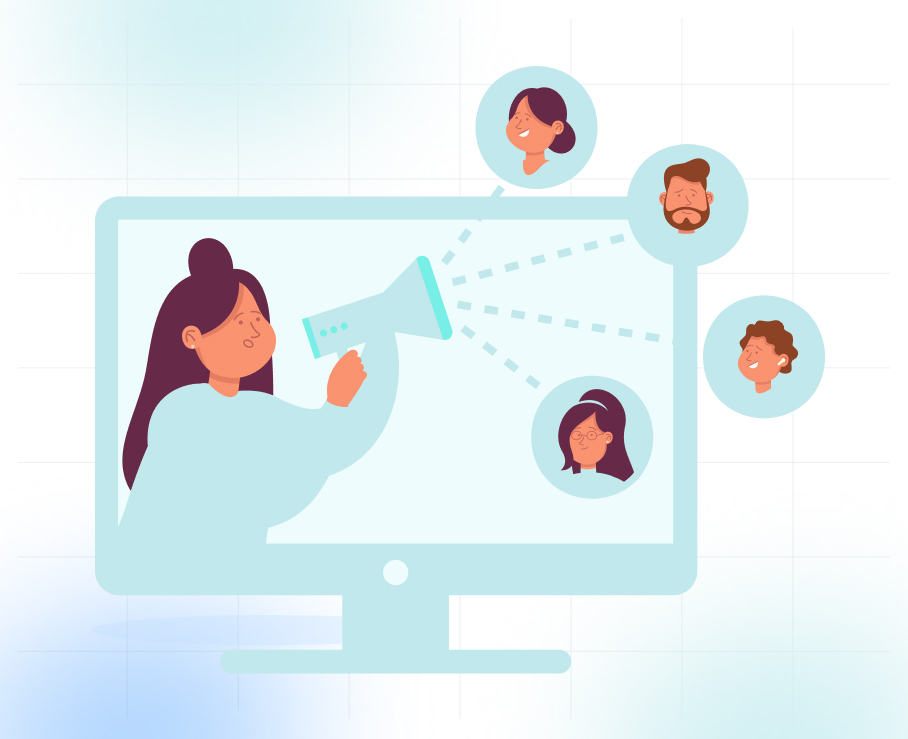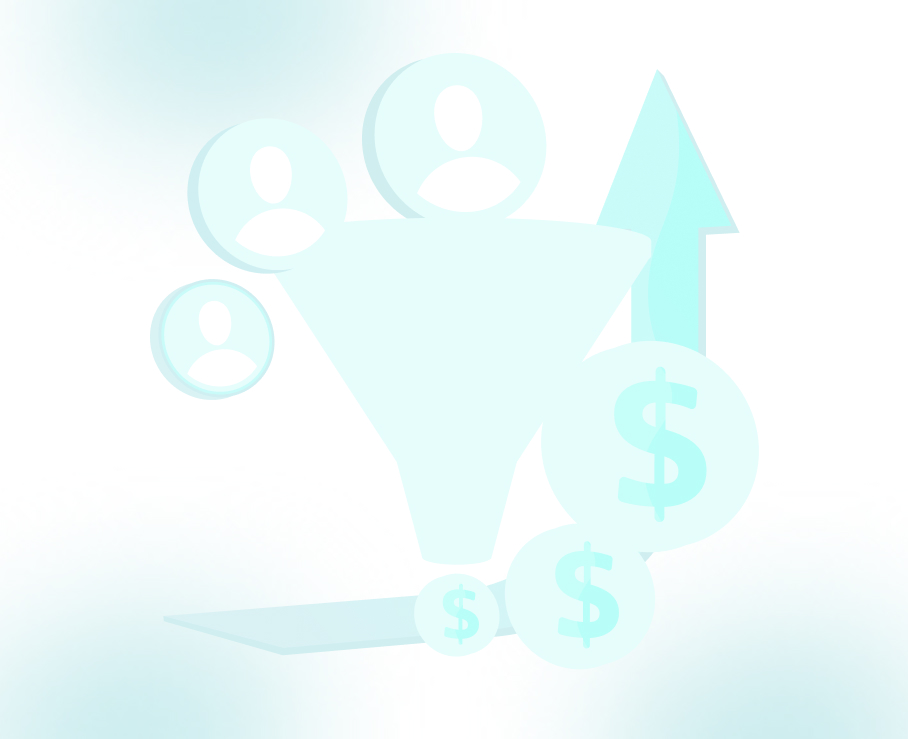
Best Demand Generation Channels for Strategy in 2025
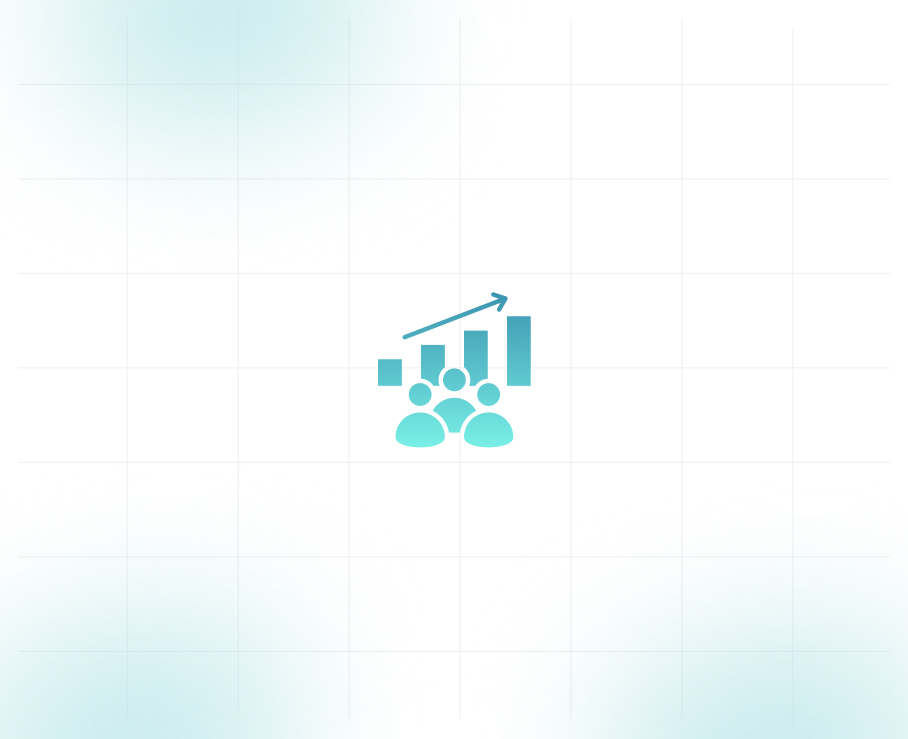
Growing a business in 2025 requires more than just launching more campaigns; it’s about choosing the right ones. Imagine running multiple marketing efforts, yet not seeing the growth you expect. This occurs when strategies fail to align with your specific business needs, audience, or objectives. The solution lies in mixing the right demand generation channels for long-term success. Understanding which channels will resonate with your audience and drive results is key.
This blog will focus on the top demand generation channels you need to consider and how to optimize them for success. Whether you're new to the process or looking to refine your current strategy, you’ll gain actionable insights to grow your business.
Key Takeaways
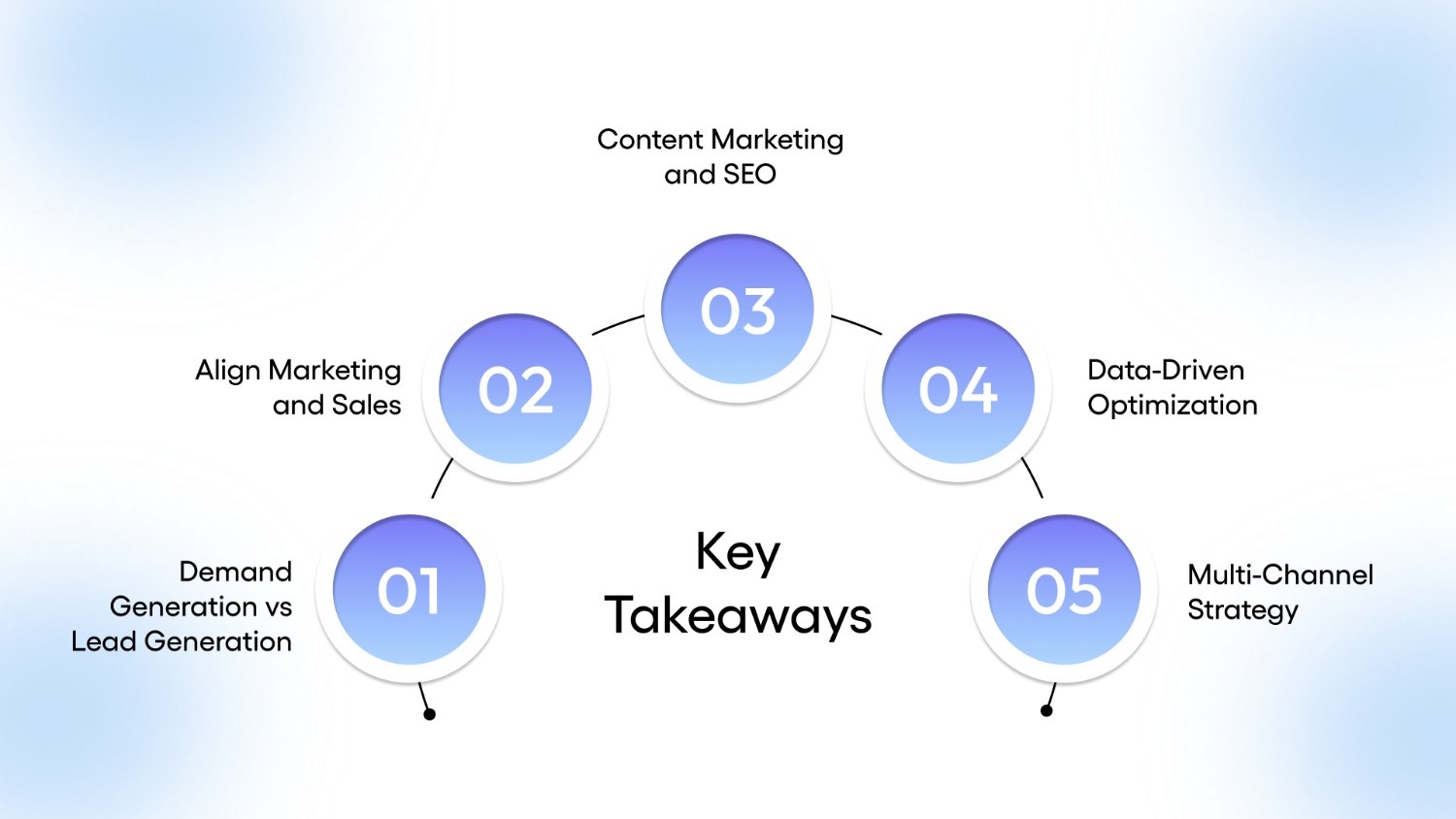
- Demand Generation vs Lead Generation: Demand generation builds awareness and trust, while lead generation focuses on capturing and converting leads into customers.
- Align Marketing and Sales: Collaboration between marketing and sales ensures efficient lead flow and higher conversions.
- Content Marketing and SEO: High-quality content and SEO are crucial for long-term brand awareness and attracting targeted traffic.
- Data-Driven Optimization: Continuously track and optimize campaigns based on performance data for better results.
- Multi-Channel Strategy: Use a mix of channels—content, email, social media, and PPC—to maximize reach and effectiveness in demand generation.
Key Differences Between Demand Generation and Lead Generation
To build a scalable pipeline in 2025, it’s important to separate demand generation from lead generation—not just in definition, but in intent, execution, and measurement.
Here’s how they can be differentiated across strategy:
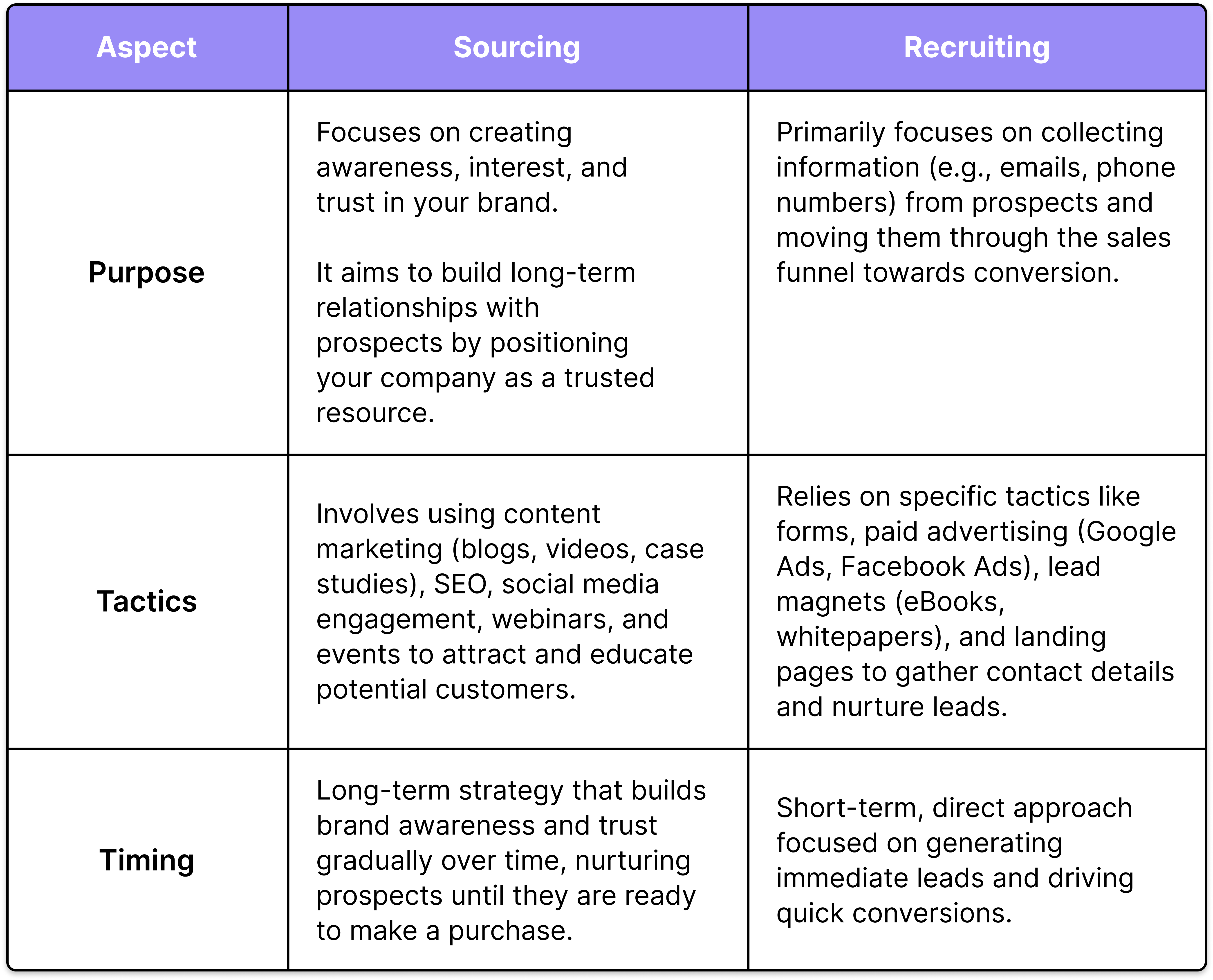
Demand generation creates the fertile ground for lead generation. Without demand generation, lead generation would have a limited pool of prospects to convert. Together, they complement each other and create a steady flow of high-quality leads.
Key Best Practices for Demand Generation Strategy
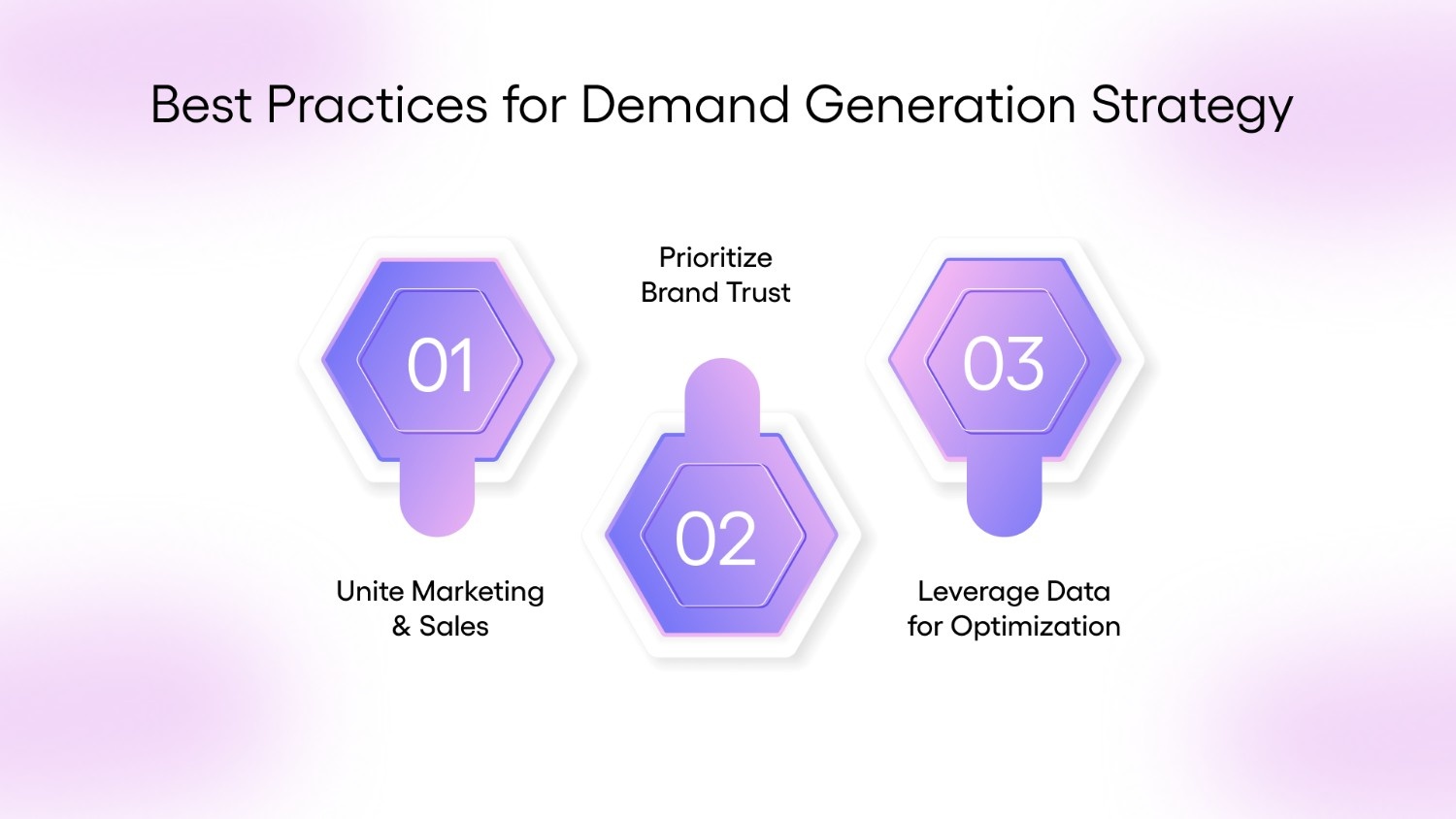
Success depends not just on the channels you use, but on how well you align your brand narrative, data, and go-to-market motion across the buyer journey. With a clear understanding of demand generation, let’s take a look at some best practices that will ensure your strategy is successful in 2025. These are the building blocks of a demand generation plan that drives measurable results:
1. Align Marketing and Sales Teams
Marketing and sales need to work together. When both teams understand the target audience and share the same goals, the entire demand generation process runs smoother. Marketing can focus on attracting high-quality leads, while sales can focus on closing them. Ensuring both teams use the same tools and track leads in real-time ensures no lead gets lost or mishandled.
2. Focus on Long-Term Brand Awareness and Trust-Building
Demand generation is a marathon, not a sprint. It's about creating lasting visibility and trust with your audience. Build that trust by consistently offering value through content that answers questions and solves problems. When people trust your brand, they’re more likely to engage when they’re ready to make a purchase. Invest in SEO and social media to amplify your content and ensure that your audience finds you when they need solutions.
3. Use Data-Driven Insights for Continuous Optimization
Data is your best friend when it comes to refining your demand generation efforts. Tracking key metrics like engagement, conversions, and ROI helps you see what’s working and what isn’t. Use this data to adjust and optimize your strategies. A/B testing your emails, landing pages, and ads will show you which variations lead to better results, helping you focus your efforts more effectively.
Continuously optimizing based on data ensures you’re always improving your campaigns.
Also Read: Demand Generation: Strategies and Benefits Explained
Top Demand Generation Channels for 2025
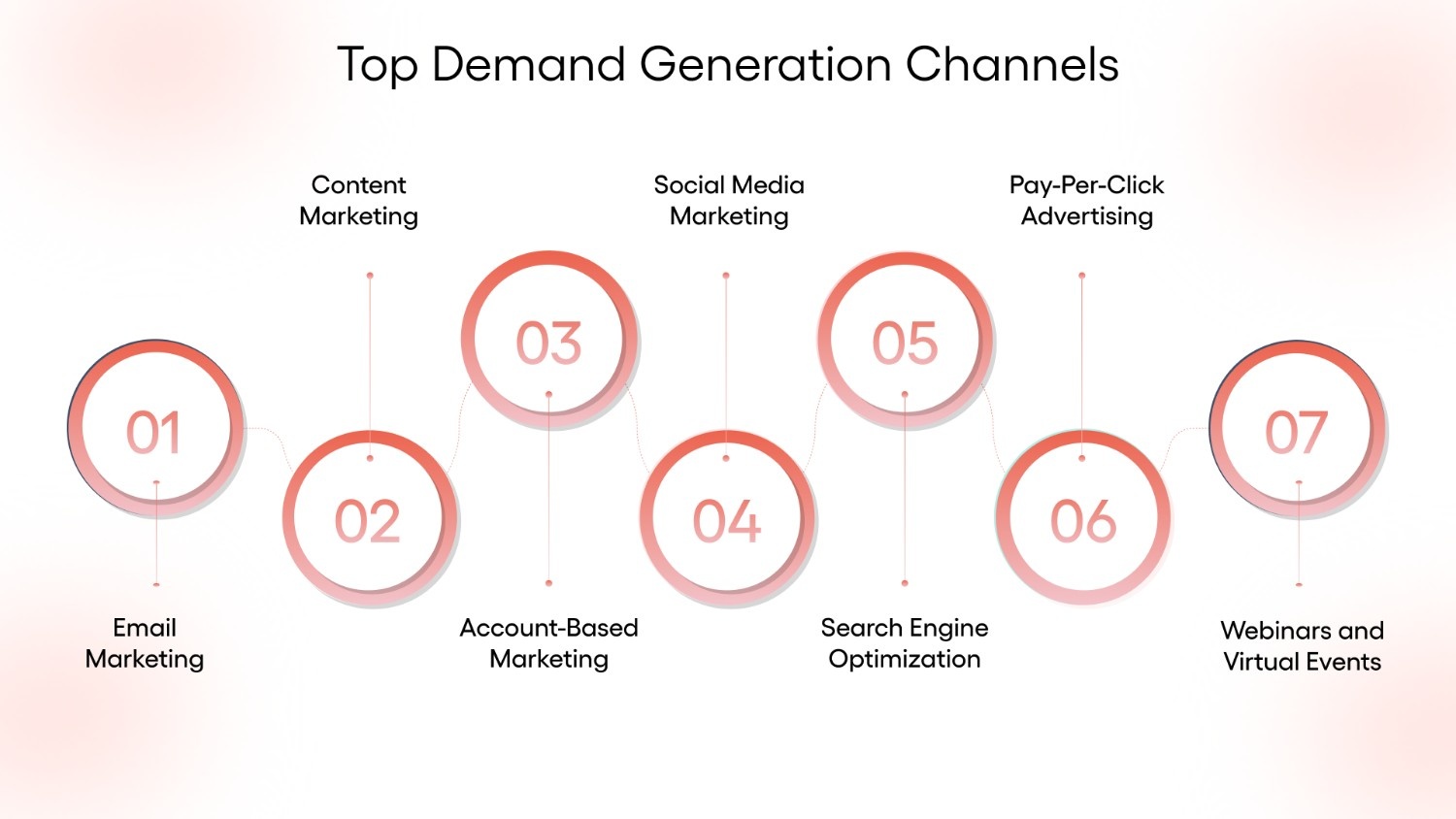
With buyers becoming more selective and the B2B landscape growing increasingly competitive, brands must engage their audience across the right touch-points with purpose and precision. The most effective channels are those that build trust early, educate consistently, and guide prospects toward intent-driven action. To succeed in demand generation in 2025, businesses need to choose the right mix of channels. These strategies, when aligned correctly, will drive growth and enhance customer relationships.
1. Email Marketing
Despite the rise of newer technologies, email marketing remains one of the most powerful and cost-effective tools for demand generation. In fact, 4 out of 5 marketers say that they would rather give up social media marketing than email marketing. With the ability to personalize emails and segment your audience, email marketing helps nurture leads and keep your brand in front of potential customers at every stage of the buyer’s journey.
How It Works:
- Targeted Campaigns: Send targeted, relevant content to segmented groups within your email list. This ensures that the emails are specific to the recipient’s needs, boosting engagement.
- Behavior-Based Triggers: Send emails based on user actions such as downloading a resource, abandoning a cart, or visiting a pricing page. These real-time responses make your outreach timely and relevant, increasing the chances of conversion.
- Clear Calls-to-Action (CTAs): Each email should have a clear and compelling CTA that drives the recipient to take the next step, whether that’s reading a blog post, scheduling a demo, or making a purchase.
Benefits:
- High ROI: According to studies, email marketing has one of the highest ROI among all digital marketing strategies.
- Lead Nurturing: Email allows businesses to nurture relationships with leads over time, keeping them engaged and moving toward a sale.
- Cost-Effective: Compared to other marketing methods, email campaigns are relatively low-cost and easy to execute.
2. Content Marketing
High-quality, informative content plays a crucial role in educating potential customers and establishing your brand as an authority in your field. In fact, 87% of businesses report that content marketing helped them create brand awareness in the last 12 months. Additionally, 74% say it generated demand and leads, while 62% found it effective in nurturing subscribers and leads. By consistently producing content that answers your audience’s questions, addresses pain points, and provides solutions, you nurture trust and guide leads further down the sales funnel.
Why It’s Important:
- SEO Integration: Content marketing is inherently tied to SEO. When you publish optimized, high-quality content, your website ranks better in search engines, attracting organic traffic from people actively looking for information.
- Lead Nurturing: Good content doesn’t just capture attention; it nurtures leads through different stages of the buyer's journey. From blog posts to case studies, content adds value at each touchpoint.
Benefits:
- Cost-Effective: Content creation is much cheaper compared to other paid methods like PPC.
- Higher Conversions: Consistently high-quality content builds trust and encourages prospects to convert into paying customers.
- Long-Term Impact: Once content is published, it continues to work for you by attracting leads long after its creation.
3. Account-Based Marketing (ABM)
ABM is a highly targeted approach where marketing and sales collaborate to focus efforts on specific high-value accounts. By personalizing campaigns for each individual account, businesses can create meaningful relationships with key decision-makers and increase the chances of closing big deals.
How It Works:
- Personalized Campaigns: Each message, piece of content, and outreach strategy is tailored specifically for the target account. This level of personalization helps businesses stand out from the noise of generic campaigns.
- Data-Driven Insights: ABM uses advanced data analytics to identify the most promising accounts, enabling businesses to focus their resources on those that are most likely to convert.
Benefits:
- Higher Conversion Rates: Personalized outreach drives stronger relationships, leading to higher engagement and conversion.
- Better Alignment of Sales and Marketing: ABM ensures that both sales and marketing teams work closely together, increasing efficiency and effectiveness.
- Improved ROI: By focusing resources on high-value prospects, ABM drives more profitable results with fewer wasted efforts.
4. Social Media Marketing
Social media platforms, particularly LinkedIn, have become essential in B2B demand generation. These platforms provide a space for businesses to showcase their expertise, engage in industry conversations, and build relationships with potential customers. Through consistent interaction and thought leadership, your business can stand out as a credible source in your field.
How It Works:
- Strategic Content Sharing: Share valuable and educational content that resonates with your target audience. This can include articles, industry news, infographics, and case studies.
- Targeted Ads: Social media ads allow you to target very specific demographics and industries, ensuring that your content reaches the right people at the right time.
- Engagement: Respond to comments, join discussions, and participate in groups to build relationships and trust with your audience.
Benefits:
- Increased Brand Awareness: With billions of active users, social media platforms offer vast potential for reaching new audiences.
- Community Building: Regular engagement with your audience helps build a loyal community around your brand.
- Cost-Effective: Compared to traditional advertising, social media is highly cost-efficient and provides measurable results.
5. Search Engine Optimization (SEO)
.png)
SEO remains a foundational strategy in demand generation. As search engines evolve, SEO becomes more sophisticated, requiring businesses to optimize for both technical aspects and user experience. A strong SEO strategy helps drive organic traffic to your website, ensuring that prospects find your content when they search for related topics or solutions.
Why It’s Important:
- Organic Traffic: SEO helps your website rank higher in search engine results pages (SERPs), attracting visitors who are already interested in your industry.
- Long-Term Value: Unlike paid ads, SEO efforts provide lasting results. Good rankings can continue to generate traffic for months or even years.
- Trust and Credibility: Websites that appear in top search results are often seen as more credible, building trust with prospects.
Benefits:
- Increased Visibility: Ranking higher in search results means more eyes on your website.
- Targeted Traffic: SEO ensures that your content is visible to users who are actively searching for solutions like yours.
- Lower Long-Term Costs: Once your site is optimized, the traffic you receive is essentially free, compared to the ongoing costs of paid advertising.
6. Pay-Per-Click (PPC) Advertising
PPC advertising is one of the most effective ways to generate immediate results. Through platforms like Google Ads, businesses can target specific keywords, locations, and demographics to ensure their ads are seen by the right people. The benefit of PPC is that you can drive targeted traffic quickly, allowing you to measure and adjust campaigns in real-time.
How It Works:
- Keyword Targeting: Choose specific keywords related to your business, ensuring that your ads appear when users search for those terms.
- Real-Time Tracking: With PPC, you can track how your ads are performing in real time, making it easier to optimize campaigns.
- Budget Control: You can control how much you spend on each click, ensuring that you don’t exceed your budget.
Benefits:
- Immediate Results: Unlike SEO, which takes time, PPC ads provide instant visibility and traffic.
- Measurable ROI: With real-time analytics, you can track your ad performance and adjust your strategy quickly.
- Scalable: Whether you’re a small business or an enterprise, PPC allows you to control your budget and scale your campaigns.
7. Webinars and Virtual Events
Webinars and virtual events are powerful tools for demand generation, providing a direct way to engage with your audience, share your expertise, and move them closer to making a purchasing decision. These events also allow for real-time interaction, helping to build stronger relationships with your prospects.
How It Works:
- Educational Webinars: Host webinars that address common pain points, explain how your product can solve them, and provide valuable insights.
- Interactive Elements: Incorporate Q&A sessions, polls, and surveys to engage participants and gather valuable data.
- Follow-Up: After the event, send follow-up emails with a summary, recording, and relevant resources to continue nurturing leads.
Benefits:
- Increased Engagement: Webinars offer a chance for real-time interaction, making it easier to build relationships with attendees.
- Thought Leadership: Hosting a well-executed webinar positions your brand as an authority in your industry.
- Global Reach: Virtual events allow you to engage with a global audience, overcoming geographic limitations.
8. Influencer Marketing
Influencer marketing involves collaborating with industry influencers to amplify your brand message. These influencers already have established trust with their followers, making their endorsement incredibly valuable for driving demand.
How It Works:
- Find the Right Influencers: Choose influencers whose audience aligns with your target market and who share your brand values.
- Collaborative Content: Work with influencers to create authentic content, whether it’s a blog post, video, or social media post.
- Track Performance: Use analytics to measure the impact of influencer campaigns, from engagement to conversions.
Benefits:
- Increased Reach: Influencers already have access to a large and engaged audience.
- Enhanced Credibility: An endorsement from a trusted influencer increases your brand’s credibility.
- Stronger Relationships: Long-term partnerships with influencers can lead to sustained brand loyalty.
By carefully selecting and combining these top demand generation channels, businesses can create a powerful strategy that not only reaches their audience but also fosters lasting connections and drives meaningful growth.
Also Read: Effective Email Marketing for Demand Generation
Choosing the Right Demand Generation Channel for Your Business
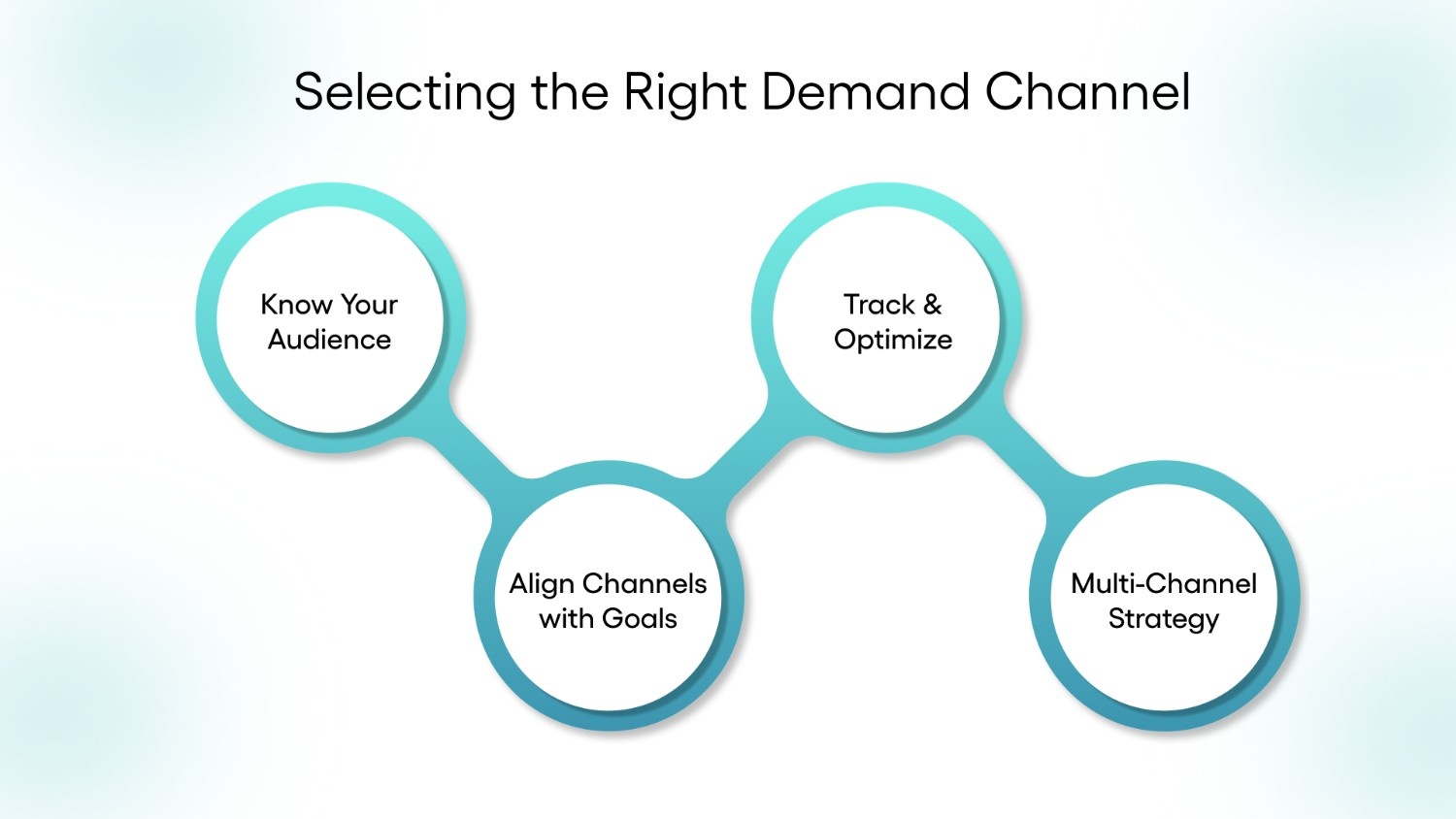
The right demand generation channels depend on your business, audience, and goals. To choose the best channels for 2025, consider the following:
1. Know Your Audience
Understanding your audience is the foundation of any successful demand generation campaign. The more you know about their preferences, pain points, and behaviors, the more tailored and effective your messaging and channel selection will be.
Think about your ideal customer—what industry are they in? What challenges do they face? What kind of content do they engage with? Start by gathering data through surveys, feedback forms, or analyzing customer interactions on social media. This will help you create detailed buyer personas, which will guide your decisions on where to allocate your efforts.
2. Align Channels with Your Business Goals
The channels you choose must align with your specific business objectives. Whether you're aiming to increase brand awareness, generate leads, or drive conversions, different channels serve different purposes.
For example:
- If brand awareness is your goal, focus on content marketing, SEO, and social media. These channels help you reach a broad audience and build trust over time.
- If your goal is to generate leads, you’ll want to focus on more targeted strategies like PPC ads or email marketing, which can directly engage prospects who are ready to convert.
Understanding this helps you avoid wasting resources on channels that don’t align with your goals and instead invest in ones that will directly support your business objectives.
3. Track, Analyze, and Optimize
Once you’ve selected your channels, tracking performance becomes essential. It’s not enough to just run a campaign and hope for the best. Monitoring engagement, conversion rates, and ROI across all channels allows you to understand what’s working and what’s not.
By reviewing your analytics regularly, you’ll be able to identify which channels are delivering the highest value. If email marketing is driving more conversions than social media, you can allocate more resources to email campaigns. On the flip side, if social media ads are falling flat, you can adjust your targeting or test new creatives.
4. Use a Multi-Channel Approach
Relying on a single channel may limit your reach. A multi-channel approach allows you to engage your audience at multiple touchpoints, increasing the likelihood of conversion. For instance, you might use content marketing to educate prospects, social media to engage with them, and email marketing to nurture them toward a decision.
The key is ensuring that your channels complement each other. If your content drives traffic to your site, email campaigns can nurture those visitors with personalized offers. Social media can support content distribution, driving even more awareness. The idea is to create a seamless, integrated experience for your audience.
How a Southern California Staffing Agency Boosted Revenue by 30x with TLM
A Southern California staffing agency, specializing in light industrial positions, faced the challenge of relying on in-house marketing and referrals, which limited their ability to scale. With no budget for a full-time salesperson, the agency struggled to generate qualified leads. We stepped in with a strategic lead generation plan targeting key decision-makers, including Operations and HR managers, within the light industrial sector.
Our approach included tailored email campaigns with unique subject lines and careful lead identification. Within the first month, the agency secured six qualified leads, resulting in two new work orders and a significant increase in website traffic. By 2022, nearly 76 appointments were generated, helping the agency increase its revenue by 30x and successfully match talent with high-demand opportunities.
Effective demand generation strategies are essential for businesses looking to attract and engage the right prospects while building a sustainable sales pipeline.
TLM Inside Sales offers specialized demand generation services designed to help businesses create awareness and interest in their products. Their approach focuses on identifying high-value leads through targeted campaigns and personalized outreach, ensuring businesses connect with the right prospects.
TLM employs advanced data mining techniques to craft compelling email scripts and schedule appointments, which streamline the sales process. They also provide account-based marketing (ABM) to focus on specific, high-value accounts, improving conversion rates. By using these methods, TLM helps companies build strong sales pipelines and consistently drive growth through efficient lead generation and qualification strategies.
FAQs
1. What are some emerging trends in demand generation for 2025?
AI, personalization, and predictive analytics are shaping demand generation, along with interactive content like webinars and live events to increase engagement and conversions.
2. How can small businesses effectively implement a demand generation strategy?
Focus on content marketing, social media, and email campaigns. Leverage targeted content and build relationships through cost-effective channels, creating awareness and engaging customers without a large budget.
3. How long does it typically take to see results from demand generation efforts?
Results usually appear in 3-6 months, but strategies like SEO and content marketing may take longer. Consistent effort is key for long-term success and sustained returns.
4. How can I integrate multiple demand generation channels without overwhelming my team?
Align channels with specific goals and focus on quality content. Ensure marketing and sales teams collaborate to maintain efficiency and avoid spreading resources too thin.
5. What role does data analytics play in optimizing demand generation channels?
Data analytics helps measure performance, track ROI, and refine strategies. Analyzing metrics like engagement and conversions enables businesses to adjust campaigns for better targeting and results.


